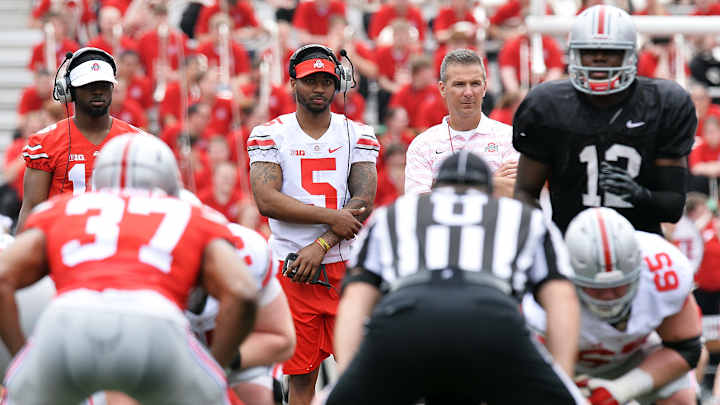Five Great What-Ifs From the Past 20 Years of College Quarterback Battles

Spring football hits full swing in April, but forgive us if we’re still not quite ready to read much into the news that comes out of it. Spring games and practices are a welcome change from the rest of the offseason as long as everyone applies the appropriate amount of skepticism to glowing reports on individual players or the remarkable turnaround of a unit that was a mess on the field just a few months ago.
Because coaches are especially loath to give out concrete information this time of year, spring ball is for speculation, and no position is the subject of more speculation than quarterback, where several high-profile jobs are up for grabs this offseason. Conference champs USC and Oklahoma have to replace Sam Darnold and Baker Mayfield, respectively, Michigan is waiting for news on Ole Miss transfer Shea Patterson’s eligibility, and Ohio State, Alabama and Florida are all reassessing their offenses for different reasons. It may look like there’s a clear favorite, and there might be a clear favorite, but in most cases we’re not going to get a definitive decision until August. And once the games begin, those decisions become prime targets for second-guessing if things don’t go according to plan.
While we wait for winners to emerge in this year’s most anticipated QB competitions, let’s take a look back at five of the more interesting quarterback battles and controversies of the past 20 years. These decisions eventually turned out well for the respective teams, but they include a handful of fascinating what-ifs at the quarterback position, amidst murky depth charts, injuries and stars who might have waited in the wings a season too long.
David Carr vs. Billy Volek, Fresno State, 1997–99
Before his beleaguered run as Texans franchise quarterback after being taken first overall in 2002, David Carr was a Heisman finalist at Fresno State, completing 64.5% of his passes and throwing for 4,839 yards, 46 touchdowns and nine interceptions in 2001, his senior season. The school retired his number in 2007.
Carr’s path to starting, though, was a winding one. He arrived as a true freshman in 1997 with the intention of playing (and potentially starting) that year. Both of the quarterbacks who played in ’96 had graduated, but sophomore Billy Volek won the job, leading the Bulldogs to a 6–6 record. The next year Volek started again, and Fresno State won five games. Carr completed 27 of 52 passes (51.9%) in spot duty over those two years, then redshirted in ’99, when the Bulldogs went 8–5 in Volek’s senior season. After assuming the starting job the following season, Carr brought the Bulldogs into the national spotlight in 2001. Fresno State opened the year with six straight wins, beating ranked teams (No. 22 Oregon State and No. 23 Wisconsin) in Weeks 2 and 3. After an Oct. 13 win over Colorado State, the Bulldogs were ranked eighth in the country—only to promptly lose to Boise State three days before the first BCS rankings were released.
A loss at Hawaii the next week effectively ended Fresno State’s challenge to college football’s ruling class, but Carr was the best quarterback in the nation that year, and it’s worth wondering whether he would have blossomed sooner if he had not been blocked by Volek. With another season of on-field development somewhere along the way, would the Bulldogs have found their way to a BCS bowl?
As for Volek, he went undrafted in 2000 but hung around in the NFL until 2011 as a backup for the Titans and then the Chargers.

Carson Palmer vs. Mike Van Raaphorst, USC, 1998
Carson Palmer’s USC career began with a quarterback battle that was nothing if not awkward. The freshman arrived at USC in 1998 as a prized recruit but opened the year as the nominal backup to sophomore Mike Van Raaphorst, who had been the Trojans’ No. 2 quarterback the year before. But it wasn’t that simple: Van Raaphorst and Palmer split time in the Trojans’ first eight games, during which they went 5–3 and lost to two ranked opponents, No. 10 Florida State and No. 12 Oregon. USC fell from the rankings after a 32–31 loss to Cal in Week 6.
On Oct. 31 against Washington, Palmer got his first start, and according to the Los Angeles Times, the quarterback rotation between him and Van Raaphorst stopped abruptly in the third quarter without either player being officially alerted. The job was Palmer’s from then on, and the Trojans finished the season 8–5; under their new starter, they beat No. 9 Notre Dame and lost just twice down the stretch, to No. 3 UCLA and to TCU in the Sun Bowl.
USC was never going to contend for a title that year, but its play down the stretch makes you wonder how the season would have gone if Palmer had gotten the job to start the year, or even just any earlier than he did. Two losses while Van Raaphorst was the starter came by less than a score—that loss to Cal and a 17–13 loss to Oregon—and if the two-QB system had been scrapped sooner, it’s easy to imagine USC winning at least one of those matchups.
Eric Crouch vs. Bobby Newcombe, Nebraska, 1998–99
Crouch won the Heisman Trophy in 2001, but his ascension to the helm of the Cornhuskers’ offense was far from smooth. He redshirted during the 1997 season because of an ankle injury, and in ’98 new head coach Frank Solich named him the backup to Newcombe, a sophomore who had played receiver the previous year. Newcombe hurt his knee in the second half of the season opener, and Crouch started two games before Newcombe returned. When the knee injury sidelined Newcombe again for the second half of the season, Crouch split time with third-stringer Monte Christo and Nebraska finished 9–4.
Newcombe got his job back ahead of the 1999 season, but he still split time with Crouch, who had to shoot down rumors that he would transfer or quit if he was not the starter. By then, there was a chorus of rumors that Crouch might transfer—all of which ended when he took over as the full-time starter in mid-September.
Nebraska went 12–1 that year, 10–2 the next season and lost the national title game in 2001 to cap Crouch’s career. Things couldn’t have worked out much better in Lincoln, but it’s still wild to wonder what a stronger vote of confidence or a cleaner bill of health in Newcombe’s favor might have meant to Crouch’s place in Huskers history—and how his hypothetical transfer might have changed the college football landscape in the early 2000s.
Troy Smith vs. Justin Zwick, Ohio State, 2004–05
Smith and Zwick came to Columbus in the same recruiting class, and Zwick won the Buckeyes’ starting job entering 2014. Smith had played the previous year in a hybrid role, but when Zwick was sidelined by injury in Week 7 against Iowa, Smith took over. The Buckeyes went 5–1 down the stretch to finish 8–4.
A suspension to Smith put Zwick back under center for Ohio State’s bowl game, a blowout win over Oklahoma State, and the opening game of 2005, a 34–14 win over Miami (Ohio). The next week, Zwick started in primetime against Texas but gave way to Smith after two series. The two split time in the second half of an eventual 25–22 loss to the Longhorns, and Smith started the next week and never looked back, winning the Heisman and bringing the Buckeyes to the national title game in ’06.
Going with Smith was far from an easy decision in 2005; Zwick was supposed to reclaim the job once he was healthy, and a dropped pass took a potential game-sealing touchdown off the board against Texas, leaving the door open for a Vince Young comeback. If that game had ended differently, would coach Jim Tressel have put Smith in the driver’s seat going forward? Tressel ended up making the right call; Ohio State finished ranked fourth in ’05 and lost the national title game in ’06.
J.T. Barrett vs. Braxton Miller vs. Cardale Jones, Ohio State, 2015
We’ll stay in Columbus for our final “what-if”, a decade after the Zwick-Smith battle. Ohio State won the national championship to cap a roller-coaster 2014 season that took an early turn when Miller injured his shoulder in preseason practice. Freshman J.T. Barrett started in his place before breaking his ankle in the final game of the regular season, giving way to sophomore Cardale Jones, who led the Buckeyes to dominant wins in the Big Ten championship game, Sugar Bowl and national title game. Jones slid seamlessly into the spotlight, completing 61.3% of his passes for 742 yards over the three-game run.
After briefly flirting with a jump to the NFL draft after just three college starts, Jones returned to school in spring 2015 as both Miller and Barrett continued to recover from their injuries. Ohio State was set to have three healthy quarterbacks who could have starred anywhere else in the Big Ten, an embarrassment of riches that applied plenty of pressure on Meyer to pick the right guy to lead another title run.
Miller converted to receiver before the season started. Barrett, technically the backup, split time with Jones early in the year and became co-starter, his dual-threat skills complementing Jones’s arm until it overshadowed it: After throwing for two touchdowns and running for two more in an October win over Penn State, Barrett was named the sole No. 1. Although the Buckeyes’ late-November loss to Michigan State would keep it out of the playoff, the season still marked a significant feat of roster management by Meyer, as all three players contributed to the team’s 12–1 campaign.
